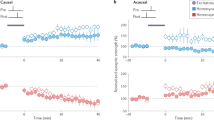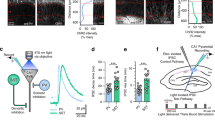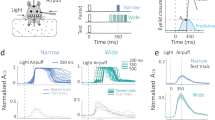Abstract
The prefrontal cortex is specially adapted to generate persistent activity that outlasts stimuli and is resistant to distractors, presumed to be the basis of working memory. The pyramidal network that supports this activity is unknown. Multineuron patch-clamp recordings in the ferret medial prefrontal cortex showed a heterogeneity of synapses interconnecting distinct subnetworks of different pyramidal cells. One subnetwork was similar to the pyramidal network commonly found in primary sensory areas, consisting of accommodating pyramidal cells interconnected with depressing synapses. The other subnetwork contained complex pyramidal cells with dual apical dendrites displaying nonaccommodating discharge patterns; these cells were hyper-reciprocally connected with facilitating synapses displaying pronounced synaptic augmentation and post-tetanic potentiation. These cellular, synaptic and network properties could amplify recurrent interactions between pyramidal neurons and support persistent activity in the prefrontal cortex.
This is a preview of subscription content, access via your institution
Access options
Subscribe to this journal
Receive 12 print issues and online access
$209.00 per year
only $17.42 per issue
Buy this article
- Purchase on Springer Link
- Instant access to full article PDF
Prices may be subject to local taxes which are calculated during checkout






Similar content being viewed by others
References
Goldman-Rakic, P.S. Cellular basis of working memory. Neuron 14, 477–485 (1995).
Miller, E.K., Erickson, C.A. & Desimone, R. Neural mechanisms of visual working memory in prefrontal cortex of the macaque. J. Neurosci. 16, 5154–5167 (1996).
Goldman-Rakic, P.S. Architecture of the prefrontal cortex and the central executive. Ann. NY Acad. Sci. 769, 71–83 (1995).
Wang, X.J. Synaptic reverberation underlying mnemonic persistent activity. Trends Neurosci. 24, 455–463 (2001).
Durstewitz, D., Seamans, J.K. & Sejnowski, T.J. Neurocomputational models of working memory. Nat. Neurosci. 3, 1184–1191 (2000).
Hempel, C.M., Hartman, K.H., Wang, X.J., Turrigiano, G.G. & Nelson, S.B. Multiple forms of short-term plasticity at excitatory synapses in rat medial prefrontal cortex. J. Neurophysiol. 83, 3031–3041 (2000).
Thomson, A.M., Deuchars, J. & West, D.C. Single axon excitatory postsynaptic potentials in neocortical interneurons exhibit pronounced paired pulse facilitation. Neuroscience 54, 347–360 (1993).
Markram, H., Wang, Y. & Tsodyks, M. Differential signaling via the same axon of neocortical pyramidal neurons. Proc. Natl. Acad. Sci. USA 95, 5323–5328 (1998).
Tsodyks, M.V. & Markram, H. The neural code between neocortical pyramidal neurons depends on neurotransmitter release probability. Proc. Natl. Acad. Sci. USA 94, 719–723 (1997).
Thomson, A.M. Facilitation, augmentation and potentiation at central synapses. Trends Neurosci. 23, 305–312 (2000).
Reyes, A. et al. Target-cell–specific facilitation and depression in neocortical circuits. Nat. Neurosci. 1, 279–285 (1998).
Reyes, A. & Sakmann, B. Developmental switch in the short-term modification of unitary EPSPs evoked in layer 2/3 and layer 5 pyramidal neurons of rat neocortex. J. Neurosci. 19, 3827–3835 (1999).
Abbott, L.F., Varela, J.A., Sen, K. & Nelson, S.B. Synaptic depression and cortical gain control. Science 275, 220–224 (1997).
Mercer, A. et al. Excitatory connections made by presynaptic cortico-cortical pyramidal cells in layer 6 of the neocortex. Cereb. Cortex 15, 1485–1496 (2005).
Thomson, A.M., Deuchars, J. & West, D.C. Large, deep layer pyramid-pyramid single axon EPSPs in slices of rat motor cortex display paired pulse and frequency-dependent depression, mediated presynaptically and self-facilitation, mediated postsynaptically. J. Neurophysiol. 70, 2354–2369 (1993).
Thomson, A.M. Activity-dependent properties of synaptic transmission at two classes of connections made by rat neocortical pyramidal axons in vitro. J. Physiol. (Lond.) 502, 131–147 (1997).
Thomson, A.M., West, D.C., Wang, Y. & Bannister, A.P. Synaptic connections and small circuits involving excitatory and inhibitory neurons in layers 2–5 of adult rat and cat neocortex: triple intracellular recordings and biocytin labelling in vitro. Cereb. Cortex 12, 936–953 (2002).
Varela, J.A. et al. A quantitative description of short-term plasticity at excitatory synapses in layer 2/3 of rat primary visual cortex. J. Neurosci. 17, 7926–7940 (1997).
Markram, H., Lubke, J., Frotscher, M., Roth, A. & Sakmann, B. Physiology and anatomy of synaptic connections between thick tufted pyramidal neurones in the developing rat neocortex. J. Physiol. (Lond.) 500, 409–440 (1997).
Galarreta, M. & Hestrin, S. Frequency-dependent synaptic depression and the balance of excitation and inhibition in the neocortex. Nat. Neurosci. 1, 587–594 (1998).
Tarczy-Hornoch, K., Martin, K.A., Stratford, K.J. & Jack, J.J. Intracortical excitation of spiny neurons in layer 4 of cat striate cortex in vitro. Cereb. Cortex 9, 833–843 (1999).
West, D.C., Mercer, A., Kirchhecker, S., Morris, O.T. & Thomson, A.M. Layer 6 cortico-thalamic pyramidal cells preferentially innervate interneurons and generate facilitating EPSPs. Cereb. Cortex 16, 200–211.
Gupta, A., Wang, Y. & Markram, H. Organizing principles for a diversity of GABAergic interneurons and synapses in the neocortex. Science 287, 273–278 (2000).
Zucker, R.S. & Regehr, W.G. Short-term synaptic plasticity. Annu. Rev. Physiol. 64, 355–405 (2002).
Mason, A., Nicoll, A. & Stratford, K. Synaptic transmission between individual pyramidal neurons of the rat visual cortex in vitro. J. Neurosci. 11, 72–84 (1991).
Markram, H. et al. Interneurons of the neocortical inhibitory system. Nat. Rev. Neurosci. 5, 793–807 (2004).
Elston, G.N. Cortex, cognition and the cell: new insights into the pyramidal neuron and prefrontal function. Cereb. Cortex 13, 1124–1138 (2003).
Markram, H. A network of tufted layer 5 pyramidal neurons. Cereb. Cortex 7, 523–533 (1997).
Giguere, M. & Goldman-Rakic, P.S. Mediodorsal nucleus: areal, laminar, and tangential distribution of afferents and efferents in the frontal lobe of rhesus monkeys. J. Comp. Neurol. 277, 195–213 (1988).
Cavada, C. & Goldman-Rakic, P.S. Posterior parietal cortex in rhesus monkey: II. Evidence for segregated corticocortical networks linking sensory and limbic areas with the frontal lobe. J. Comp. Neurol. 287, 422–445 (1989).
Gabbott, P.L., Warner, T.A., Jays, P.R., Salway, P. & Busby, S.J. Prefrontal cortex in the rat: projections to subcortical autonomic, motor, and limbic centers. J. Comp. Neurol. 492, 145–177 (2005).
Yuste, R., Gutnick, M.J., Saar, D., Delaney, K.R. & Tank, D.W. Ca2+ accumulations in dendrites of neocortical pyramidal neurons: an apical band and evidence for two functional compartments. Neuron 13, 23–43 (1994).
Larkum, M.E., Zhu, J.J. & Sakmann, B. A new cellular mechanism for coupling inputs arriving at different cortical layers. Nature 398, 338–341 (1999).
Rhodes, P.A. & Llinas, R.R. Apical tuft input efficacy in layer 5 pyramidal cells from rat visual cortex. J. Physiol. (Lond.) 536, 167–187 (2001).
Berger, T., Larkum, M.E. & Luscher, H.R. High I(h) channel density in the distal apical dendrite of layer V pyramidal cells increases bidirectional attenuation of EPSPs. J. Neurophysiol. 85, 855–868 (2001).
Magee, J.C. Dendritic hyperpolarization-activated currents modify the integrative properties of hippocampal CA1 pyramidal neurons. J. Neurosci. 18, 7613–7624 (1998).
Kalisman, N., Silberberg, G. & Markram, H. The neocortical microcircuit as a tabula rasa. Proc. Natl. Acad. Sci. USA 102, 880–885 (2005).
Douglas, R.J., Mahowald, M., Martin, K.A. & Stratford, K.J. The role of synapses in cortical computation. J. Neurocytol. 25, 893–911 (1996).
Mongillo, G., Amit, D.J. & Brunel, N. Retrospective and prospective persistent activity induced by Hebbian learning in a recurrent cortical network. Eur. J. Neurosci. 18, 2011–2024 (2003).
McCormick, D.A. Brain calculus: neural integration and persistent activity. Nat. Neurosci. 4, 113–114 (2001).
Gao, W.J., Krimer, L.S. & Goldman-Rakic, P.S. Presynaptic regulation of recurrent excitation by D1 receptors in prefrontal circuits. Proc. Natl. Acad. Sci. USA 98, 295–300 (2001).
Fisher, S.A., Fischer, T.M. & Carew, T.J. Multiple overlapping processes underlying short-term synaptic enhancement. Trends Neurosci. 20, 170–177 (1997).
Magleby, K.L. Short-term changes in synaptic efficacy. Synaptic Function (eds. Edelman, G.M., Gall, W.E. & Cowan, W.M.) 21–56 (Wiley, New York, 1987).
Larkum, M.E., Kaiser, K.M. & Sakmann, B. Calcium electrogenesis in distal apical dendrites of layer 5 pyramidal cells at a critical frequency of back-propagating action potentials. Proc. Natl. Acad. Sci. USA 96, 14600–14604 (1999).
Acknowledgements
This paper is dedicated to Patricia S. Goldman-Rakic, who wholeheartedly supported and supervised this study before she passed away suddenly on July 31 2003. She will always be an inspiration for our work. We are grateful to D.A. McCormick, T. Koos and W.J. Gao for comments on the experimental design; O. Melamed for testing mathematical synaptic modeling; and M. Pappy and A. Begovic for technical assistance. We also thank M. Tsodyks for performing preliminary network modeling studies to better understand the potential functions of facilitation and PTP in recurrent excitation and for his comments on the paper. This work was supported by the National Institute of Mental Health (grant RO1), the Natalie V. Zucker Award, the Charlton Research grants to Tufts University School of Medicine and, in part, by the National Alliance for Autism Research.
Author information
Authors and Affiliations
Corresponding author
Ethics declarations
Competing interests
The authors declare no competing financial interests.
Supplementary information
Supplementary Fig. 1
Facilitating time constant (F) vs. ages of the ferrets. (PDF 56 kb)
Supplementary Fig. 2
Synaptic facilitation between layer 5 pyramidal neurons in different cortical areas of juvenile rats (p13 – p17). (PDF 57 kb)
Supplementary Fig. 3
The EPSP amplitudes and patterns of three E–types of excitatory connections during the train stimulations. (PDF 46 kb)
Supplementary Table 1
Structural and functional architecture of the layer 5 pyramidal networks in ferret mPFC and VC. (PDF 104 kb)
Supplementary Table 2
E-Types vs. multiple parameters of PCs and synaptic connections. (PDF 57 kb)
Supplementary Table 3
Quantitative comparison of complex and simple PCs in the ferret mPFC. (PDF 74 kb)
Rights and permissions
About this article
Cite this article
Wang, Y., Markram, H., Goodman, P. et al. Heterogeneity in the pyramidal network of the medial prefrontal cortex. Nat Neurosci 9, 534–542 (2006). https://doi.org/10.1038/nn1670
Received:
Accepted:
Published:
Issue Date:
DOI: https://doi.org/10.1038/nn1670
This article is cited by
-
Synaptic Facilitation: A Key Biological Mechanism for Resource Allocation in Computational Models of Working Memory
Cognitive Computation (2024)
-
Heterogeneous encoding of temporal stimuli in the cerebellar cortex
Nature Communications (2023)
-
Chlorpromazine, an Inverse Agonist of D1R-Like, Differentially Targets Voltage-Gated Calcium Channel (CaV) Subtypes in mPFC Neurons
Molecular Neurobiology (2023)
-
Angular gyrus: an anatomical case study for association cortex
Brain Structure and Function (2023)
-
Reduced variability of bursting activity during working memory
Scientific Reports (2022)



